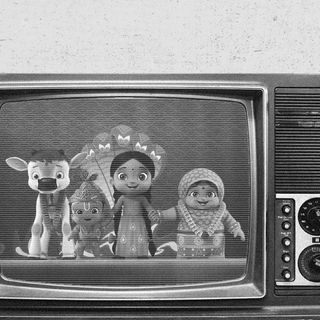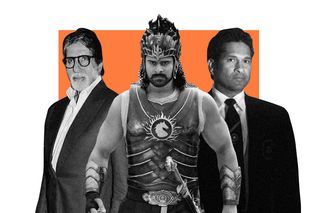
Why We Idolize Some People As Heroes
People tend to develop deep attachments to individuals who might represent a belief system. But pedestalizing someone has its costs.

Some years ago, a samosa vendor went to Amitabh Bachchan’s house with a seemingly innocuous demand. His idolization was such he wanted Bachchan to touch all his snacks, so he could distribute them as prasad later to the spree of fans that stand outside the actor’s Bombay house.
The veneration is hardly exaggerated. The idea of hero-worshipping––of putting leaders and famous people on an unimpeachable pedestal––is a culture all too familiar to us. It is one that thrives in sports, cinema, political ideologies, and daily anecdotes. Think the celebration of the “Baahubali” franchise, cut-outs of superstars towering on people, the festivities around the release of any Rajnikanth movie, well-endowed statues, or the discourse around any and every cricketer. A spirit of deference shapes public and ideological discourse.
The propensity to idolize has psychological roots. The hero narrative fulfills “important cognitive and emotional needs, including the need for wisdom, meaning, hope, inspiration, and growth,” Scott T. Allison and George R. Goethals wrote in a 2015 article.
According to them, the hero-worship culture serves two functions: one is epistemic (related to knowledge) and the other energizing. “The light which enlightens, which has enlightened the darkness of the world,” historian and philosopher Thomas Carlyle writes, referring to the radiance of a hero. “This not as a kindled lamp only, but rather as a natural luminary shining by the gift of Heaven,” he notes, calling this figure “a flowing light-fountain.”
Knowledge creation happens through emulation. These people with social agency provide a script for action, help unpack fundamental truths about life, and fuel emotional intelligence. Their real-life translations are not always as constructive. The Hindi film industry, for instance, insists on crafting male lead characters who are self-destructive when in love to attract sympathy. “Manipulative, self-destructive love in films turn into copycat actions that are criminal in the real world,” The Swaddle noted in an article last year. A slew of Shah Rukh Khan films already come to mind, no?
A patriarchal and masculine society exhibits “subconscious guilt towards women” and “making goddesses of women worthy of worship only in a divine form is not uncommon,” writer Janaki Venkataraman told Al Jazeera, referring to a nine-feet-tall statue of Sonia Gandhi in Andhra Pradesh. J Jayalalithaa, the former chief minister of Tamil Nadu, for instance, is hailed as a divine figure, a mother, and an icon to followers.
On a visceral note, these stories exist as extensions of ourselves. The idol inspires psychological growth, embodies personal aspirations, helps with moral encouragement, and energizes the person with a carefully crafted charisma. “…a hero worshiper experiences the highest emotions of which man is capable: A sense of the exalted,” author Andrew Bernstein wrote in “Heroes, Legends, Champions: Why Heroism Matters.” What Batman was to Gotham City, or what doctors are to people during the pandemic, embodies this dynamic. Reflecting on their struggles and victories becomes an exercise in seeking inspiration.
“Film heroes and heroines who have mass appeal are venerated by the less fortunate, impressionable youth who yearn for a role model and aspire to see themselves in these politicians or movie stars,” Tamil writer Vaasanthi noted. Of course, there are pitfalls to this unquestioning acceptance. The adulation of actor Sanjay Dutt in the wake of the 1993 Mumbai blasts was telling of Dutt’s “larger-than-life” hold over imagination. The media was reporting on what the actor ate and what he wore, unwittingly overshadowing the crimes in the public narrative.
A woman wrote in an Elon Musk fan blog: “Those who religiously follow Elon Musk have to have a certain element of madness and craziness in [their] personality… The things that he aspires to, his core values, and his missions make you want to do these crazy things. Fear never comes into us. You feel so alive.” Emulation and worshipping, psychologists have noted, are two things conflated with each other.
“In our culture anyway, especially in modern times, the heroic seems too big for us, or we too small for it,” author Ernest Becker wrote in “Denial of Death.”
“The truth about the need for heroism is not easy for anyone to admit. In the more passive masses of mediocre men, it is disguised, as they humbly follow out the roles that society provides for their heroics and try to earn their promotions within the system, allowing themselves to stick out, but ever so little and so safely.”
Related on The Swaddle:
Why We Feel Close to Celebrities We Have Never Met
Our choice for a hero, and the context in our times, is what makes the discourse around hero-worshipping layered. The first part is self-evident. Paul Meadows, a researcher at the Montana State University, identified multiple understandings of the hero in “The Scientific Study Of the Hero.” The hero is regarded as a paradigm. Think of them as an exemplar (messiah, Robinhood, emancipator), a specialized model (a doctor, lawyer), a promotional device (war victims or political bureaucrats), or a recreational agent (folk tales, hero of a romance or drama).
Hero worship cannot be understood in silos. Sometimes, it’s not even about the hero. Some sociologists note the culture of hero worship is more about the worshipper than the ideas they worship. The social milieu is what shapes and fuels any desire to idolize famous people as role models.
“The individual excellence that cricket provides also helped in taking it to a different level — bhakti, as we call it. That’s where the shift in popularity happened,” Ram Guha told Fifty Two while talking about the role of hero worship in cricket. For him, the trifecta of Sunil Gavaskar, Kapil Dev, and Sachin Tendulkar made the difference in popularity between hockey and cricket.
To go back to Thomas Carlyle, the hero is “a flowing light-fountain, as I say, of native original insight, of manhood and heroic nobleness;—in whose radiance all souls feel that it is well with them.”
The fallout of any culture that builds a pedestal for heroes is evident: uncritical adulation and megalomania become tools of propaganda and distortion, a trend more worrying in a post-truth age. Babasaheb Ambedkar, in his last speech to the constituent assembly in November 1949, said, “Bhakti or hero-worship is a sure road to degradation and to eventual dictatorship.” Critics have noted that instances of putting the current Indian prime minister’s image on vaccination certificates, or plastering medal ceremonies with that of his image, also subconsciously feed a culture of idolization.
While cultures and ideologies may evolve with time, the markers of idolization endure through history. The power dynamic once created by worshipping people is prone to misuse and weaponization. To accept a hero and worship them may be a cultural necessity, but the question is: what is the cost of letting worshipping become a principal duty?
Saumya Kalia is an Associate Editor at The Swaddle. Her journalism and writing explore issues of social justice, digital sub-cultures, media ecosystem, literature, and memory as they cut across socio-cultural periods. You can reach her at @Saumya_Kalia.
Related


How Daydreaming Inspires Productivity at Work
